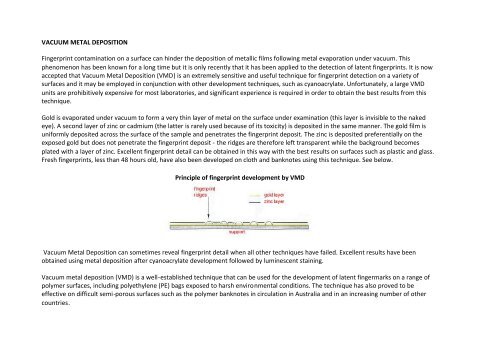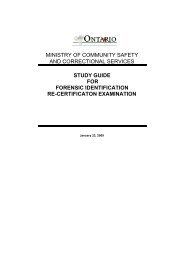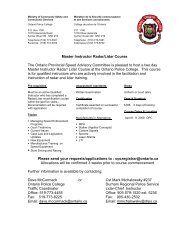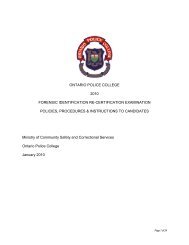General Study Guide - Ontario Police College
General Study Guide - Ontario Police College
General Study Guide - Ontario Police College
You also want an ePaper? Increase the reach of your titles
YUMPU automatically turns print PDFs into web optimized ePapers that Google loves.
VACUUM METAL DEPOSITION<br />
Fingerprint contamination on a surface can hinder the deposition of metallic films following metal evaporation under vacuum. This<br />
phenomenon has been known for a long time but it is only recently that it has been applied to the detection of latent fingerprints. It is now<br />
accepted that Vacuum Metal Deposition (VMD) is an extremely sensitive and useful technique for fingerprint detection on a variety of<br />
surfaces and it may be employed in conjunction with other development techniques, such as cyanoacrylate. Unfortunately, a large VMD<br />
units are prohibitively expensive for most laboratories, and significant experience is required in order to obtain the best results from this<br />
technique.<br />
Gold is evaporated under vacuum to form a very thin layer of metal on the surface under examination (this layer is invisible to the naked<br />
eye). A second layer of zinc or cadmium (the latter is rarely used because of its toxicity) is deposited in the same manner. The gold film is<br />
uniformly deposited across the surface of the sample and penetrates the fingerprint deposit. The zinc is deposited preferentially on the<br />
exposed gold but does not penetrate the fingerprint deposit - the ridges are therefore left transparent while the background becomes<br />
plated with a layer of zinc. Excellent fingerprint detail can be obtained in this way with the best results on surfaces such as plastic and glass.<br />
Fresh fingerprints, less than 48 hours old, have also been developed on cloth and banknotes using this technique. See below.<br />
Principle of fingerprint development by VMD<br />
Vacuum Metal Deposition can sometimes reveal fingerprint detail when all other techniques have failed. Excellent results have been<br />
obtained using metal deposition after cyanoacrylate development followed by luminescent staining.<br />
Vacuum metal deposition (VMD) is a well-established technique that can be used for the development of latent fingermarks on a range of<br />
polymer surfaces, including polyethylene (PE) bags exposed to harsh environmental conditions. The technique has also proved to be<br />
effective on difficult semi-porous surfaces such as the polymer banknotes in circulation in Australia and in an increasing number of other<br />
countries.

















